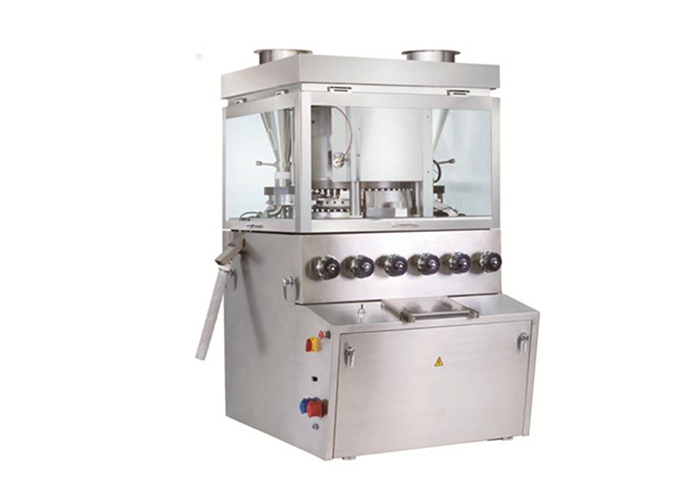The tablet press is mainly used for tablet technology research in the pharmaceutical industry. Also called tablet compression machine, tablet punching machine. The tablet press is an automatic continuous production equipment that presses granular objects into round, special-shaped, and text, symbols, and graphics tablets. Some pharmaceutical tablet presses have burrs and dust during tablet compression and should be equipped with a elevating tablet deduster to remove dust at the same time (more than twice), and must meet GMP specifications.
What’s Tablet Press?
According to the terminology standard, there are the following definitions of tablet press:
Tablet Pressing Machine
A machine that presses dry granular or powdery materials into tablets through a mold.
Single Punch Tablet Press
A tablet press with a pair of molds doing vertical reciprocating motion.
Rotary Tablet Press
A tablet press in which multiple molds evenly distributed on a rotating turntable make a vertical reciprocating motion according to a certain track.
High Speed Rotary Tablet Press
A rotary tablet press in which the axis of the mold rotates with the turntable at a linear speed of not less than 60m/min.

Structure and Composition of Tablet Press
The earliest tablet press consisted of a pair of punches. The punch moved up and down to press granular materials into tablets. This machine was called a single-punch tablet machine and later developed into an electric flower basket tablet press. The working principle of these two tablet presses is still a one-way compression based on manual compression molds, that is, when the tablet is compressed, the lower punch is fixed and only the upper punch moves and pressurizes. In this method of tableting, due to the inconsistency of the upper and lower forces, the density inside the tablet is uneven, and problems such as splitting are easy to occur.
In response to this shortcoming of the unidirectional tablet press, a rotary multi-stroke bidirectional tablet press was born. The tablet press presses up and down at the same time uniformly, so that the air in the drug particles has ample time to escape the die hole, improves the uniformity of the tablet density, and reduces the phenomenon of splitting. In addition, the rotary tablet press also has the advantages of small machine vibration, low noise, low energy consumption, high efficiency and accurate tablet weight.
Rotary tablet press is a machine in which multiple sets of dies uniformly distributed on the turntable move circularly according to a certain trajectory, and the granular materials are compressed into tablets through a pressing wheel. A tablet press with a linear speed ≥60m/min that the punch rotates with the turntable is called a high-speed rotary tablet press. This high-speed rotary tablet press has a forced feeding mechanism, and the machine is controlled by a PLC with automatic pressure adjustment and control. Film weight, reject waste film, print data, display failure shutdown and other functions, in addition to controlling the difference in film weight within a certain range, it can automatically identify and eliminate quality problems such as missing corners and loose chips.

The shape of the tablets pressed by the tablet press is mostly oblate at first, and later developed into shallow and deep arcs on the upper and lower sides, which is for the needs of coating. With the development of special-shaped tablet presses, tablets with oval, triangle, oval, square, diamond, and toroidal shapes have been produced. In addition, with the continuous development of preparations, due to the requirements of compound preparations and time-release preparations, special tablets such as double-layer, triple-layer, and core-packing have to be made on a special tablet press.
With the development of market demand, the scope of application of tablet presses has become wider and wider. It is no longer simply limited to compressing Chinese and Western medicine tablets, but can also be widely used to compress health food, veterinary medicine tablets, and chemical tablets: such as camphor pills. Sanitary balls, washing blocks, Smurf blocks, art powder cakes, pesticide tablets, etc., food tablets: chicken essence blocks, isatis root blocks, divine song tea blocks, compressed biscuits, etc.
